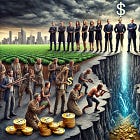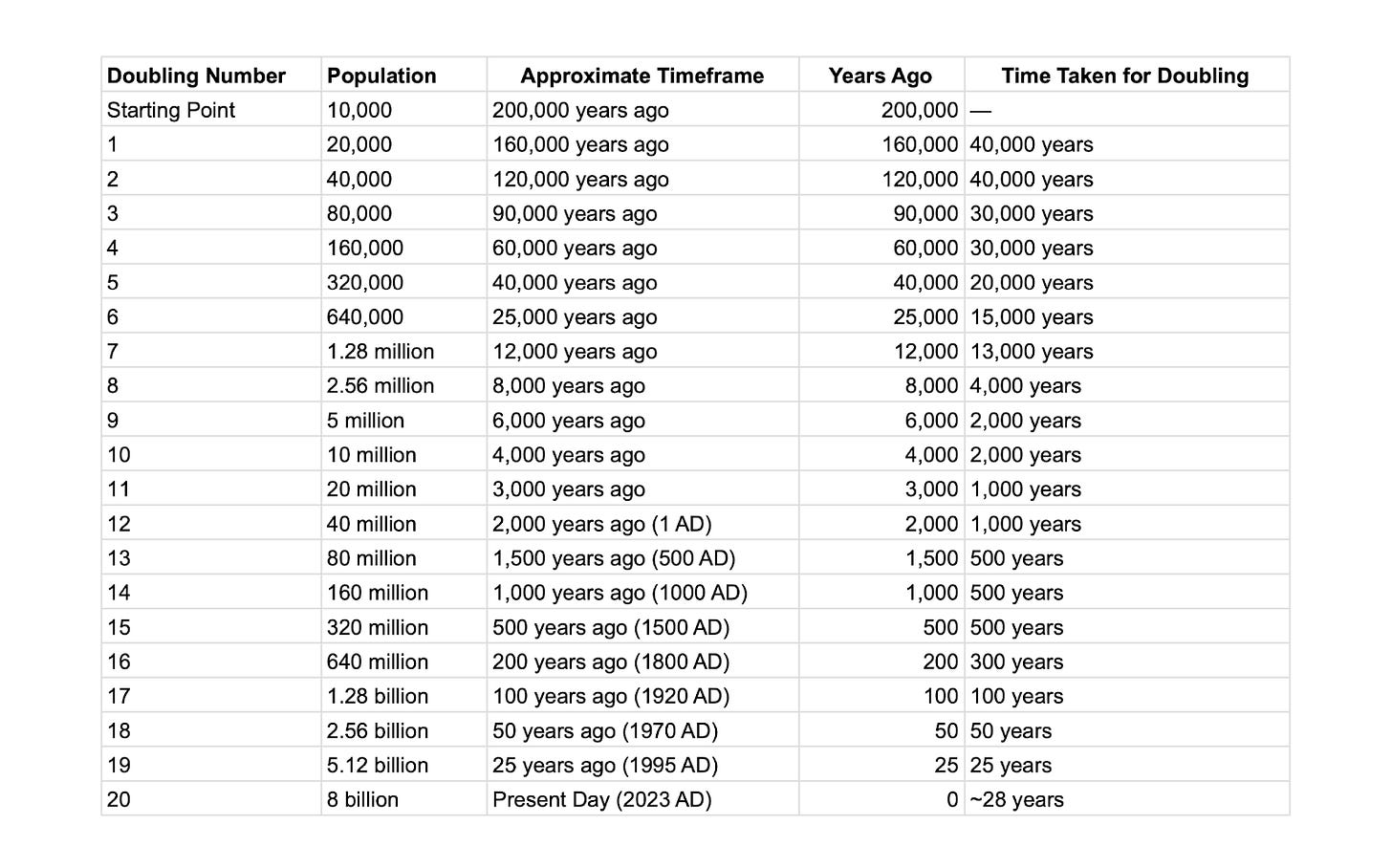Present Day Trends of a Collapsing Society
Introduction to Collapse Part II - The Present
Just 200,000 years ago ancient humans began to emerge from Africa with but a few thousand in numbers, beginning their journey across this vast and verdant planet. By the end of the last Ice Age 12,000 years ago, humans emerged into the Holocene’s warming period around 5-10 million strong. Astonishingly, in just the last 200 years our population has exploded from 1 billion to over 8 billion humans.
"The greatest shortcoming of the human race is our inability to understand the exponential function." — Albert A. Bartlett
Just in case Bartlett is correct, let’s make sure we understand what he meant. An exponential function in mathematics describes something that doubles after a fixed amount of time, and each subsequent doubling happens more quickly.
See Also Part I and III of this series:
Take a look at the last column on the right in the table below to see how fast the human population doubling interval has increased more recently. That’s the exponential function.
Once it took tens of thousands of years for the human population. Now it takes a couple of decades. This pattern correlates with other exponential patterns of growth in pollution, environmental destruction, resource consumption, food production, and much more. Are there then limitations to this sort of growth in a closed system like Earth?
The Limits to Growth
That is the essential question that a team of scientists at MIT sought to answer in 1972. This team developed a groundbreaking computer model to analyze the long-term consequences of global population growth, resource consumption, and environmental degradation. This model, known as Limits to Growth, was one of the first to simulate the interactions between these factors on a global scale. The study explored various future scenarios, with the most famous being the "business-as-usual" scenario.
Under the business-as-usual scenario, the model predicted that if humanity continued on its current path—pursuing unchecked economic and population growth without regard for resource limits or environmental impacts—society would eventually face collapse. This collapse would not mean the complete extinction of humanity, but rather a severe and rapid decline in global industrial capacity, food production, and population. The model suggested that this collapse could occur within the 21st century, driven by the overuse of natural resources and the resulting environmental degradation, which would undermine the very systems that sustain human civilization.
What is collapse?
This is a good place to talk about what exactly collapse means. I get the idea from things I read online that many people are under the impression that collapse is defined as a sudden and total end of all things modern. Something akin to how Hollywood sometimes portrays a zombie apocalypse. They will then use that depiction to undermine any belief in life after collapse. I think it's important to dispel that myth.
In his book “Collapse” (2005) Jared Diamond defined collapse as “a drastic decrease in human population size and/or political/economic/social complexity, over a considerable area, for an extended time.”
Gaya Herrington, who we’ll talk about next, defines it more as a steep decline from a previous peak in various critical metrics, such as industrial output, food production, population and human well-being. This decline does not mean the complete disappearance of humanity but rather a significant reduction in the complexity and functioning of society.
The Real-World Data 50 Years Later
50 years after the Limits to Growth model was first introduced, Gaya Herrington, a sustainability researcher, revisited this influential work to evaluate its accuracy in light of real-world data. Herrington analyzed empirical data from the past several decades, comparing it with the scenarios predicted by the original model to see if the trajectories described by MIT scientists in 1972 were aligning with actual global trends. She highlighted 4 scenarios from the original study that most closely align with present. Below are the four scenarios summarized in charts.
BAU is business as usual. BAU2 is similar to BAU, only they assumed resource availability would double compared to the historical trends from 1972. CT, stands for comprehensive technology, representing how innovation could mitigate the severity of declines. And finally SW is the “stabilized word” scenario, which would involve global society abandoning the goal of economic growth to stabilize resource and environmental depletion, reduce pollution while maintaining peak human well-being.
Catch her presentation at the end of the post.
Findings of Gaya Herrington
Herrington discovered that the current global data closely matched the BAU2 scenario. This scenario, which predicted eventual societal collapse due to overconsumption of resources and environmental degradation, showed striking parallels with today's reality. Indicators such as resource depletion, industrial output, population growth, and pollution levels were unfolding much as the model had anticipated, suggesting that the world was indeed on an unsustainable path.
Herrington's analysis highlighted that while some technological advancements and policy changes have occurred, they have not been sufficient to shift the world onto a more sustainable trajectory. As she says, theres zero evidence of so-called “green growth.” Her work reaffirmed the urgency of addressing the environmental and resource challenges identified in the original study, underscoring that without significant course correction, the dire predictions of societal decline could become a reality within this century.
Resource scarcity is becoming more pronounced, as essential materials like fresh water, arable land, and fossil fuels are being consumed at unsustainable rates. Despite technological advancements and efforts to improve efficiency, the demand for these resources continues to rise, outpacing the Earth's capacity to replenish them. This increasing strain on resources is pushing the global system closer to critical thresholds, beyond which recovery becomes difficult, if not impossible.
At the same time, pollution levels, including greenhouse gas emissions and other forms of environmental degradation, are escalating, contributing to climate change and biodiversity loss. These environmental impacts are beginning to undermine the very systems that support human life, such as agriculture, clean water supplies, and stable climates. The cumulative effect of these pressures is a future of societal collapse, as described in the BAU2 scenario.
The alignment of current data with this scenario suggests that our current trajectory is a steep decline in global industrial capacity, food production, and population. Without significant and immediate changes to how we manage resources and address environmental challenges, the world will face severe disruptions within the coming decades, leading to widespread social, economic, and ecological crises.
Can We Change Course?
Considering there are other scenarios we aren’t far removed from, what are the chances we might change our current trajectory to avoid a severe collapse? I’ve written about this topic before, highlighting the conundrum of addressing system-level crisis in a politically viable way.
And as discussed in part I of this series, a common thread among collapsing societies is they double down on long-held beliefs, particularly the ones that have been beneficial to the society up to the point of collapse, when they become detrimental. The current global order is indeed built on growth. Is it even reasonable to expect or assume global society will abandon these foundational beliefs in a crisis?
Gaya Herrington does have some suggestions in her book about how we could do this, but I’m not at all optimistic about the prospects. So then what do we do? Throw up our hands and quit? Embrace Buddhism and forsake the world?
I encounter many people online who feel that way, and it is not my intention to go after them here. Rather, I think there are several ways we can look at the present as an opportunity to do something good despite what’s coming.
Justice Planning
At the very least, we can answer the call of my friends at Just Collapse. They advocate for working on a community-level response for a more just collapse. The people who will suffer most are the most vulnerable of society. We will all no question suffer, but we can collectively begin to work on lessening that suffering. That may include incorporating planning for action outside of the political establishment. Things like local food production, security, and other adaptive strategies. Maybe this movement will grow and create more sustainable and resilient communities around the globe.
We’ll take a deep dive into some of these possibilities in Part III of this series. In the meantime, thanks for reading and supporting us here on Collapse Curriculum. I hope you’ll subscribe to stay in touch. Feel free to add your own thoughts in the comments, which I have open to all. Please respect everyone’s opinions, even if you politely disagree. Discussion welcome.








Someone posted one of those "summer family get-together" photos in the notes here the other day. There must have been 50 people, maybe more, and the caption read to paraphrase "my grandmother did this!" Like this was something to be proud of. I thought, someone should have hung her first. Okay, i didn't think that, but it was a horrifying spectacle to me.
A question for you. Do you think we are right now in rapidly escalating decline (that much seems obvious) or full-on collapse? I mean, how do you know when the boundary is crossed, in real-time? Given that when you fall off a cliff you may just think for span there you are flying. I like the depiction of the abandoned city. A big improvement over how they look right now. The idea of us engineering "a just collapse" is hysterically absurd, by the way. A real leg-slapper. And so "us" of the oil age, so believing we are in control.
This post and linked video are a mini-course on climate change and a great service for all who take the time to study them. UN Food and Agriculture Organization is one of the few places one can inferred information on per capita food production; a decrease in per capita food production is one of the leading indicators of collapse per some of the complex systems studies: https://openknowledge.fao.org/server/api/core/bitstreams/d1b7ac97-7ad3-4c95-98fd-3568def8a75c/content